#japanese reggae pop
Explore tagged Tumblr posts
Text
youtube
via My Analog Journal - Kay Suzuki: Japanese Reggae Pop from the ‘70s & ‘80s
In 2023, I reportedly listened to over 150 genres of music (So says Spotify, I think that number's a little low.) but one genre that I was really obsessed with this year is city pop. You know Japanese city pop when you hear it. It ain't exactly challenging music. Very light lounge listening. Very early '80s. All in Japanese.
Anyway, there was a spinoff from that genre where producers took the most accessible elements of reggae and put them into city pop style songs. So, no great vocal performances, but light, fun music. I like to cook with it on sometimes.
There's a compilation album coming next year called "Tokyo Riddim" from Time Capsule (link to the playlist here) that I think captures the vibe really well. but if you wanna catch the vibe of a live mix, the man Kay Suzuki has a set here that describes the genre perfectly.
Enjoy!
#sound#music#Japan#My Analog Journal#city pop#80s aesthetic#japanese music#reggae#Jamaican music#jamaica#japanese reggae pop#Youtube
1 note
·
View note
Text
youtube
TODAY by Sumiko Yamagata / やまがたすみこ
Album: Flying Year: 1977 Label: Columbia (Blow Up sublabel) Lyrics: Takashi Matsumoto / 松本隆 Music: Hiroshi Sato / 佐藤博
#japanese new music#sumiko yamagata#1977#columbia records#takashi matsumoto#hiroshi sato#subcategory: jazz-rock/reggae#almost city pop#やまがたすみこ#Youtube
0 notes
Text


music 🎶🖤
#me#my post#music#rap music#r&b music#r&b/soul#hip hop#country music#edm music#house music#lofi#pop music#electronic music#rock music#screamo#reggae music#jazz music#alternative#bedroom music#japanese music#indie music#reggaton#stress relief#anxiety relief#drug#pain#help#spotify#soundcloud#apple music
2 notes
·
View notes
Text
youtube
いとうせいこう & Tinnie Punx - 東京ブロンクス
From The Album: 建設的 (1986)
[Japanese Hip Hop, Experimental Hip Hop, Rap Rock, Punk, Mid-School Hip Hop, Pop Reggae]
#music#japanese hip hop#experimental hip hop#rap rock#punk#mid school hip hop#pop reggae#hip hop#Youtube
0 notes
Text
🆕 「 Girls Lovers Reggae Vol.1」 by FAREWELL, MY D.u.b Available for streaming worldwide!🌐 Added to our weekly playlist 🎧 https://spoti.fi/3lgjH73
0 notes
Text
THE ROCKET-LIKE RISE OF LEE SCRATCH PERRY INTO THE CONTEMPORARY ART WORLD
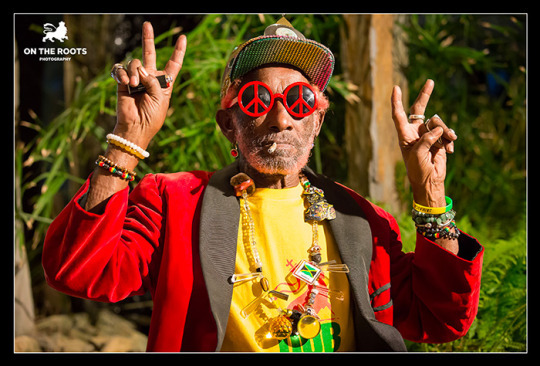
© Reggae.fr / On The Roots Kevin Buret - 2016.
Lee Perry: A Pop Artist
Altogether dancer, singer, musician, producer, eccentric, visionary, shaman and genius, Lee “Scratch” Perry is to Jamaican music, some would say, what Sun Ra is to free jazz, George Clinton to funk or Salvador Dali to painting. Born in 1936, in the small town of Kendal in Jamaica, Lee “Scratch” Perry participated in a concrete way in each of the important stages of the history of Jamaican music. A true pillar of reggae and dub, his innovations have left their mark on many other musical genres around the world, including: US rap; UK punk, jungle, ambient and trip-hop; Japanese electronic music; without forgetting European techno and avant-garde music. Today, Lee Perry is no longer of this world, in the flesh at least. He died late August 2021 at the age of 85. Nevertheless, his name unquestionably stays in vogue. It is still on the lips of pop stars like the Rolling Stones, The Orb, The Roots and Major Lazer, and we can also gradually hear it spreading in the contemporary art world.
The Black Ark: Sound and Image
Lee Perry always evolved into a very personal visual universe, starting with his legendary home recording studio, the Black Ark, at the origin of the most innovative sounds of the second half of the 1970s in Jamaica. Originally thought to be a sort of sanctuary for Rastafarians, the Black Ark was a very confusing place, whose walls were covered in cryptic inscriptions and floors served as dumping grounds for installations and other DIY projects, all of them being zanier than the next – a sculpture was even embedded inside one of the walls, says his ex-wife, Pauline Morrison, in People Funny Boy written by David Katz (2000: 324).

© Adrian Boot, circa 1977/ 1979. Part of JKD’s private photo collection.
This Baroque environment was part of the eccentric personality of the genius producer, embodied in an increasingly extravagant look and outfits over the ages: during his final years, he used to dye his hair and beard yellow, green of even pink, and he was decked out in completely fantastical clothes, personalised with pins and other fanciful objects. And when he was not wearing his famous golden baseball cap, adorned with glittering CDs, badges or religious illustrations, he was wearing a Native American feathered war bonnet or a wizard hat.

© Lee Scratch Perry painting in his studio in Switzerland (Blue Ark), 2018. Photo: Lorenzo Bernet. Courtesy: The Visual Estate of Lee Scratch Perry / suns.works.

© Lee Scratch Perry wearing his wizard hat in his studio in Switzerland (Blue Ark), 2019. Photo: Lorenzo Bernet. Courtesy: The Visual Estate of Lee Scratch Perry / suns.works.
It is more than clear Lee “Scratch” Perry was an artist with a capital A, a complete, total, full-time artist who did not switch to Rainford Hugh Perry (his real name) in private and who did not lock himself into a single box: the one of music. He did not play a role, he lived through his art full-time and was attracted as much to sounds as to visuals. Indeed, the latter played a significant role in his galaxy, in his symbolism, in his perception of the world. According to Perry himself, the image was the preferred channel for conveying messages (often subliminal), it was therefore necessary for him to be wary of them and to be able to reappropriate them. In some way, it can enable us to understand his involvement (conscious or unconscious) in the visual arts, which by the way was not recent. Indeed, reading his brilliant biography written by David Katz, we can easily realize that Perry had always been interested in his physical and cultural environment, the objects that surrounded him as well as the pop culture into which he loved to dig.
Even in the late 1950s, long before he began his musical career, when he worked in construction in Negril and drove bulldozers, Perry focused his attention on the noises associated with construction work and the energies of machines as they came into conflict with nature, one can read in People Funny Boy. He even reported an almost supernatural experience, resulting in his departure from this seaside resort located at the far western part of Jamaica to the capital Kingston in the early 1960s: “I get an overload from throwing stones down there for maybe two weeks. I started making positive connection with stones, by throwing stones to stones I start to hear sounds. When the stones clash I hear the thunder clash, and I hear lightening flash, and I hear words, and I don’t know where the words them coming from. These words send me to King-stone: to Kingston” (2000: 8).
Until the end of his life, stones occupied a pre-eminent place in his resolutely mystical universe. He regularly collected them, piled them up, carried them to various places, and even cooked them in a pot on the fire. In the late 1970s, that is precisely what happened, says Pauline Morrison, in their home in Washington Gardens, Kingston, which also housed his legendary recording studio.
“Pauline has claimed she was preparing a meal one afternoon when she noticed an odd smell coming from the kitchen. When she checked the pot, she found that Scratch had emptied the simmering contents into the mud of the yard, substituting a pan full of rocks in their place on the fire” (2000: 324). “If you see our house, this guy write all kind of shit on the wall, on the fence…” (2000: 323). And the Jamaican singer, Vicky Nelson, added, “my foot would be in paint, I would get rocks and all those nature things” (2000: 345).
As Pauline Morrison and Vicky Nelson suggest, Lee Perry also paid a great importance to writing and painting at the time of Black Ark. We must indeed go back very far in time to understand the links he developed with the visual arts and everything encompassed by this generic term: calligraphy, graffiti, assemblages, collages, installations, and painting among others. In short, everything that would make up his artistic inventory alongside his music. Lee “Scratch” Perry had always been a compulsive sketcher and graffiti artist, feeling a certain need to fill, if not to say overload, empty surfaces. From the end of the 1970s onwards, he even seemed to pay as much attention to the decoration of his studio as to musical production at times.
"Jean-Michel Basquiat himself called him a significant source of inspiration for his paintings"
Moreover, it is not surprising that at that time Lee Perry also commissioned art from Rastafarian artist Jah Wise to decorate the Black Ark. Indeed, he had the walls surrounding the studio decorated with huge, multicoloured murals painted by Robert Van Campbell aka Jah Wise. A portrait of Haile Selassie was placed just above the door so that all would have to ‘bow’ to Jah upon entering or leaving; to the left of his head was Selassie in his feline form as the Conquering Lion of Judah. Another wall had a life-size mural of the Super Ape, tree and spliff in hand, while the inside of the studio depicted African ancestors in chains and Rastafarian tri-colour flags. As time passed, such images would be altered and re-cast as Perry sought to express different concepts; like the music that was coming from inside the studio, its illustrated walls would seldom remain static. He also erected a sign with a ‘Management Order’ by the front gate, proclaiming that the premises included the site of a private house where women and children lived; all who sought to enter were to wait for official permission and once inside, were to refrain from using indecent language. (In People Funny Boy, French edition, 2012: 476-477).
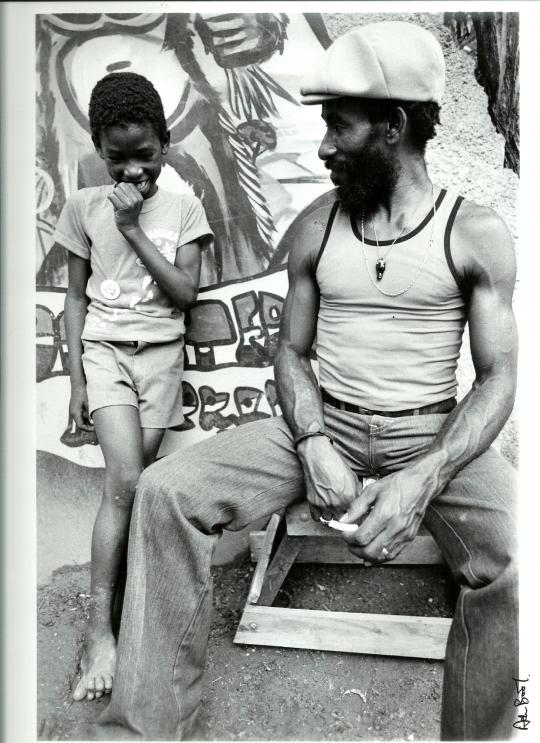
© Adrian Boot, 1978. Lee Perry and his son, Mark (aka Omar), at the Black Ark. In the background there is a glimpse of the “Super Ape” painting done by Jah Wise. Part of JKD’s private photo collection.
youtube
Lee “Scratch” Perry outside Black Ark Studios, Jamaica, 1977, premium footage from the Don Letts Archive available on YouTube.
All things considered, Lee Perry’s artistic source of creation originated far away back in time and widely developed during the seething cultural period of the Black Ark. Back in the 1970s, Lee Perry was already considering himself as a multi-disciplinary Artist and was already in contact with avant-garde people not only from Jamaica but also from England (Don Letts, John Lydon from the Sex Pistols, The Clash etc.).
After the Black Ark was destroyed by fire on one morning in the summer of 1983, Lee Perry experienced a very long period of exile, first in England, then in Switzerland where he moved out at the end of the 1980s with his new and last wife, a sultry queen of the Zurich nightlife, born Mireille Ruegg, only daughter of a couple of Swiss restaurateurs, who would become his manager. It was then that he started to show more and more interest in art, in a more professional way shall we say, the collections of four-handed paintings executed with British visual artist, Peter Harris, first between 2007 and 2009, then between 2014 and 2015, constituting a very good illustration of the extent of his pictorial work.
The Meeting with British Visual Artist Peter Harris
“How does a 40-year-old white British artist meet up with a 70-year-old black shaman from Jamaica and make a real connection? I am not a Rastafarian black man from the ghettos of Trench Town, I am a lower middle class Catholic son of an absent submariner father who moved from place to place and, as a consequence, has no ‘roots’ to speak of. This has led to a lifetime of what I suspect will be an unachievable search for home. I have lived through a series of popular culture ‘father figures’ who have been inspirational guides such as Bob Dylan, Francis Bacon, Johnny Rotten and Picasso, and Lee is one I’ve been lucky enough to meet in person. […] Lee’s experience and understanding - or “overstanding” - of Babylon is very different to my version of it. Lee’s version of Babylon might come from the Rasta’s view of western society as being corrupt, a world of ‘politricks’ and oppressors of Rastafarians. My version of Babylon is also about a society that oppresses our lives, but it is more about the unrelenting trajectory of existence. It might go something like this: birth, school, dreams, peer pressure, music, drugs for fun, student loans, love, jobs, depression, pressure, holidays, insecurity, mortgage, drugs for escaping, children, stress, peer pressure, cars, responsibilities, doubts, reality, panic attacks, bills, new clothes. In it but not of it, pets, vet bills, gym, mid-life crisis, new haircuts, hair loss, beer bellies, guilt, cigarettes, alcohol, food, cancer, medicine, pensions, fear, death” (interview conducted with Peter Harris by JKD, 2014).
In February 2005, Lee “Scratch” Perry responded positively to a request from Peter Harris who wanted him to be in a film he was working on, called Higher Powers. “I wanted different sorts of people who represented different kinds of higher powers,” Harris explains, “almost archetypal people. It might be a powerful gangster outside the law or a police chief, to someone with a spiritual higher power, or someone who totally doesn’t believe in higher powers. For the creative higher powers, or the visionary people, I thought of Ken Russell and Lee Perry” (2012: 898).
The concept was an appealing one for Perry, so permission was granted for Harris to film him at home on February 14th. The British visual artist interviewed him on various themes such as: destiny, faith, redemption, luck, love, doubt, etc. He then returned to London to edit the results. Subsequently, Peter Harris planned further filming sessions with Perry for the same film project. On October 1, 2007, Peter Harris' film, Higher Powers, was screened for the first time at the Lüneburg Art Hall in Germany. Perry appeared in the company of such controversial personalities as former gangster Dave Courtney, gay rights activist Peter Tatchell, Conservative politician Boris Johnson, Reverend Joanna Jepson (who has campaigned against the use of abortion for “eugenic reasons”), paranormal spoon-bender Uri Geller, Tibetan Buddhist monk Akong Tulku Rinpoche, and conspiracy theorist David Icke (2012: 910). Some years earlier, Harris had approached performers such as David Bowie, Siouxsie Sioux and members of the Stranglers, for ideas that he could turn into paintings; with a similar concept in mind, Harris returned to Switzerland in November 2007 to make a series of collaborative drawings with Lee Perry, ultimately inducting Perry into the world of fine arts.
“I’d done a Self-Portraits by Proxy series before,” Harris explains, “in which every person who had affected my life and influenced me, I asked for an idea, and then made that idea into a painting, but with Lee, it was a bit different. I called him up and said, ‘I’ve got these themes from the film, and I want you to give me the first image that comes into your head’; I’d say, ‘Luck,’ or whatever, and he would come up with some mad image, and I’d make it a drawing. Then I took all the drawings to his place in Switzerland, and he said we should cut them up; he was remixing them, like a record, taking something from one drawing and placing it with another, and it was more like a ceremony, or an Obeah ritual, so he spent a lot of time trying on different hats and costumes, as if he was getting into character. We started work at seven, and worked right through till four in the morning, and he had one CD that was just on repeat the whole time” (2012: 911).
On September 10th, Perry performed a special live dub set at London’s Tabernacle, with Adrian Sherwood at the mixing desk and live video animation behind him, as the climax of the “Higher Powers” art exhibition arranged by Peter Harris, which showcased the drawings the pair had produced in 2007, as well as a number of collaborative paintings they made together in Switzerland on August 15th 2009. The artwork dealt with typical Perry themes, such as social injustice, religious dogma, the unequal distribution of wealth, sex, and personal vengeance; some of the paintings bore the man’s handprints and footprints as well, while both paintings and drawings were marked by Perry’s declamatory graffiti (2012: 920). Images of the painting sessions carried out jointly by Peter Harris and Lee Perry in 2007 and 2009 as well as footages from the Tabernacle exhibition are viewable in the documentary, Lee Scratch Perry's Vision of Paradise, directed by Volker Schaner in 2015, an excellent film which also retraces the unusual trajectory of Lee Perry and clearly reflects the great part that art played in his daily life.
youtube
Lee Scratch Perry’s Vision of Paradise by Volker Schaner.
And as for the hundred works of art that the two artists made together between 2014 and 2015, they draw their inspiration from the Bible, from the Book of Revelation in particular.“With its tales of evil deeds, redemption and the apocalypse. It is rich in imagery, metaphor and parables. A parable is not a literal thing. It would not make sense to our modern minds, informed by readily available facts, to take it so. Language and visual language are vehicles for getting at some ‘truth’ as truth is often inexpressible” (interview conducted with Peter Harris by JKD, 2014).
This meeting with Peter Harris was clearly a step forward for Lee Perry into the world of contemporary art.

“Ja Pay” © Peter Harris and Lee “Scratch” Perry, biro pen and permanent marker pen on paper, 42 x 42 cm, 2007.
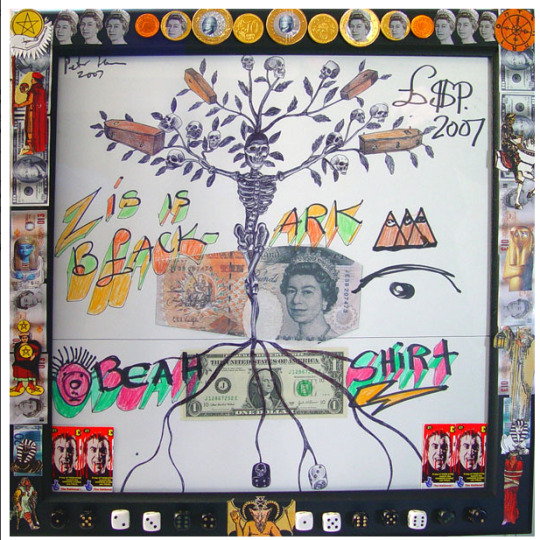
“Zis Is Black Ark” © Peter Harris and Lee “Scratch” Perry, collage, biro and pencil on paper, 42 x 42 cm, 2007.

“Judgement Com Yow” © Peter Harris and Lee “Scratch” Perry, marker pen, oil, acrylic paint on canvas, 123 x 109 cm, 2009.

“Super Ape” © Peter Harris and Lee “Scratch” Perry, biro pen, marker pen, felt tip and gold leaf paint on paper, 30 x 42 cm, 2014-2015.

“Super Man in Space” © Peter Harris and Lee “Scratch” Perry, biro pen, marker pen, felt tip and gold leaf paint on paper, 30 x 42 cm, 2014-2015.
The Rise of Lee Perry into the Contemporary Art World
A contemporary artist status confirmed by his induction into the Pantheon of sculptures made by Xavier Veilhan - using a 3D scanner - and held simultaneously in New York and Paris in the spring of 2015. During this double exhibition organised around music and simply named “Music”, the French visual artist wanted to pay tribute to the great music producers who had been shaping the soundtrack of our time, including Philippe Zdar, Pharrell Williams, Quincy Jones, Daft Punk, Rick Rubin, Brian Eno and Lee “Scratch” Perry. The latter therefore appeared in this impressive list of geniuses (around twenty in total), whose collectors are now snapping up statues made from a range of varied materials (from wood to metal through polyurethane resin).
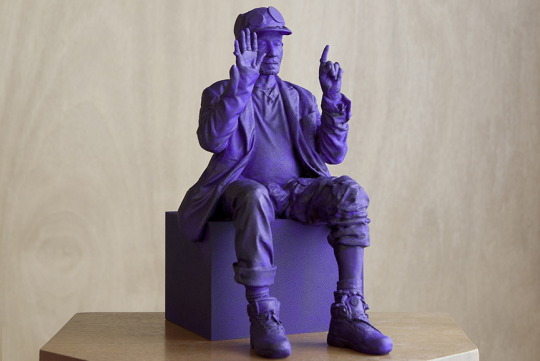
“Lee Scratch Perry”, © Xavier Veilhan, “Music” exhibition, aluminium-filled polyurethane resin, plywood, acrylic paint, varnish, 122,5 x 62 x 86 cm, 2015.
What followed was a portrait (on paper this time) dedicated to him by the monthly art French magazine, Beaux-Arts, in 2017, on the occasion of the exhibition “Jamaica Jamaica!” held at the Paris Philharmonic (April 4-August 13, 2017), where the above-mentioned statue created by Xavier Veilhan was moreover exhibited.
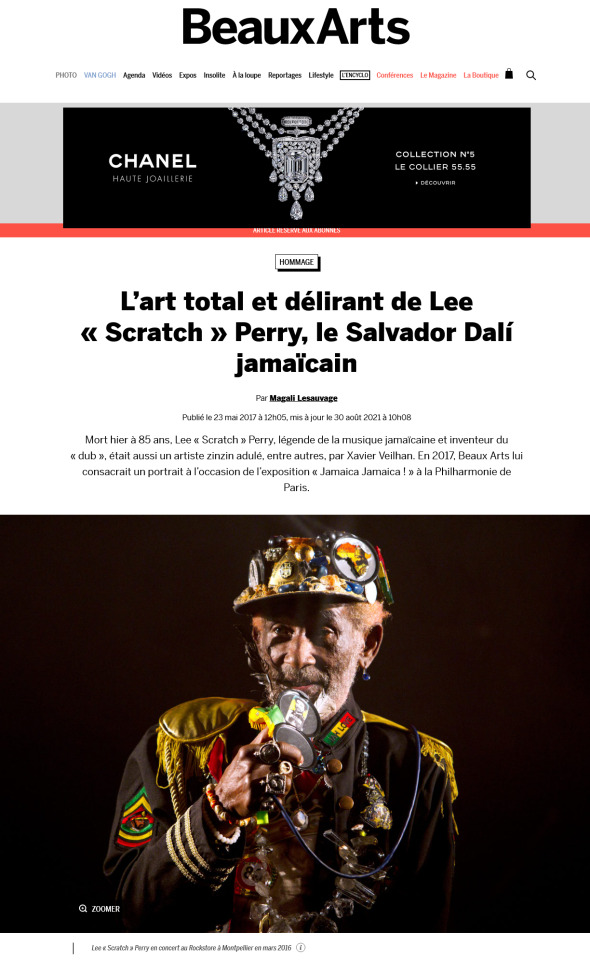
© article published on 23 May 2017 by Magali Lesauvage in Beaux-Arts.
Lee Perry made the front cover of other art magazines, such as the Italian biannual, Kaleidoscope, in 2020-2021.
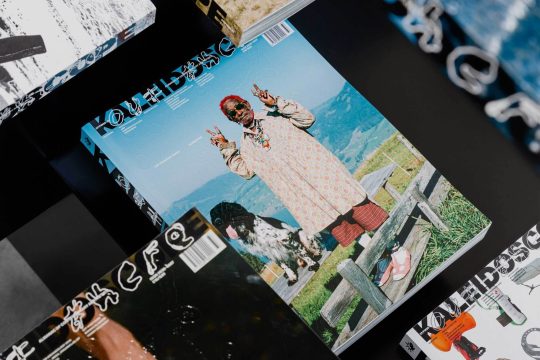
© Kaleidoscope, number 37, 2020-2021.
Finally, alongside all this, Lee Perry's visual artworks have been the subjects of numerous personal and group exhibitions around the world, starting with his very first solo exhibition held at the Californian gallery Dem Passwords from November 13 to December 11, 2010 under the name “Secret Education”.

© Dem Passwords, « Secret Education » exhibition, 2010.
Three other solo exhibitions were organised by this same gallery in 2013 (“Repent Americans” from April 20 to June 15), 2014 (“The Death of Baphomet” from August 29 to October 11) and 2016 (“Judgment Repentance God Order” from June 16 to July 30).
"these many art exhibitions around the world have coincided with the new curatorial team responsible for the visual estate of Lee “Scratch” Perry and headed by Lorenzo Bernet (...) this new, fresh and dynamic curatorial team seems to come up with creative and innovative ideas"
In that same year, Lee Perry also did an art show in New York, from June 29 to July 29, 2016 as part of a collective exhibition entitled “A Being in the World” and held at Salon 94 on the lower east side of Manhattan. His pieces of work were thus exhibited alongside those of a very heterogeneous panel of artists, including the African-American self-taught artist and former slave, Bill Traylor (1854-1949), and Maia Ruth Lee (born in 1983 in South Korea).

© Dem Passwords, « Judgement Repentance God Order » exhibition, 2016.
Then, Lee Perry multiplied international shows: at the Swiss Institute in New York in 2019, at the 2021 São Paulo Bienal, at the Museum of Contemporary Art of Rome in 2022, and at the Cabinet Gallery in London as well as at the 2023 Art Cologne international art fair, just to name a few. In total, Lee Perry actively took part in no less than fifteen international exhibitions between 2016 and 2023, and almost half of them in the last couple of years, which is the guarantee of a rocket-like rise on the contemporary art scene. Regarding this latter point, it is crucial to emphasize that these many art exhibitions around the world have coincided with the new curatorial team responsible for the visual estate of Lee “Scratch” Perry and headed by Lorenzo Bernet, a Zurich-based gallerist, curator and art dealer who is also the man behind the suns.works gallery. Therefore, it might be no exaggeration to say that this art world rocket rise relates to this new, fresh and dynamic curatorial team that seems to come up with creative and innovative ideas.

“Flood Sun” © Lee Scratch Perry, collage, markers and acrylic on wooden board, 60 x 100 cm, 2020. Courtesy: The Visual Estate of Lee Scratch Perry / suns.works.
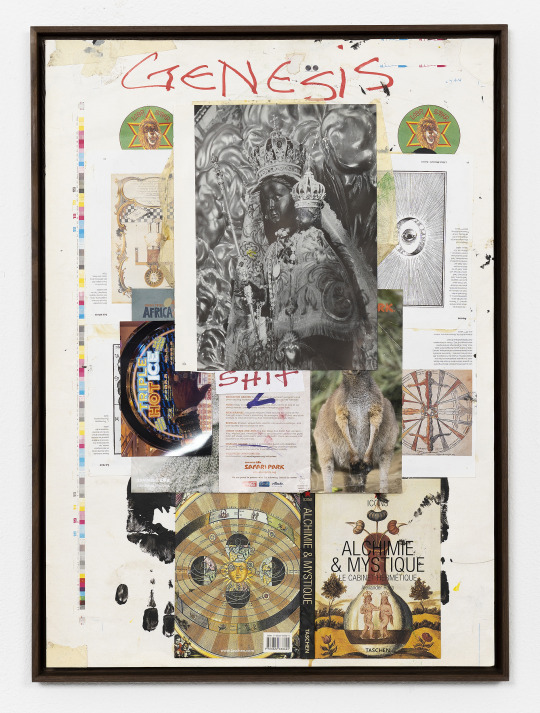
“Genesis” © Lee Scratch Perry, collage and acrylic on paper, 70 x 50 cm, 2020. Courtesy: The Visual Estate of Lee Scratch Perry / suns.works.

“Pisces and Aries (Yin Yang)” © Lee Scratch Perry, collage and acrylic on canvas, 170 x 140 cm, 2020. Courtesy: The Visual Estate of Lee Scratch Perry / suns.works.
It is also important to underline the presence of some of his drawings, paintings, collages and other installations in the collections of art aficionados like Sir Raymond Douglas Davies aka Ray Davies (former songwriter and lead vocalist for the legendary British rock band the Kinks), English record producer Adrian Sherwood (Coldcut, Depeche Mode, Primal Scream, Sinéad O'Connor, Lee “Scratch” Perry, Dennis Bovell), Mexican producer, remixer and composer Camilo Lara, and the British artist couple formed by Tim Noble and Sue Webster, as well as prestigious institutions such as the Bonnefanten Museum in Maastricht (NL). Others should soon be included in the permanent collections of the National Gallery of Jamaica as well as the Smithsonian Institution in Washington which currently investigates, along with the National Museum of African American History and Culture, Afrofuturist expression through art, music, and activism among others: an exhibition (March 23, 2023 – August 18, 2024) in which Lee “Scratch” Perry appears next to avant-garde jazz legend Sun Ra and the leader of African American Funkadelic style George Clinton - the threesome being tied to raw, original and pioneering Black aesthetic forms. And again, one owes this real tour de force to the new curatorial team headed by Lorenzo Bernet!
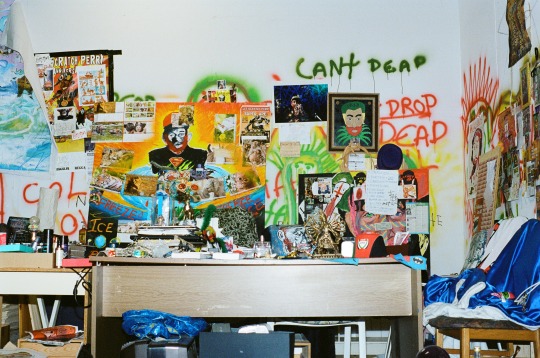
“Blue Ark (studio view)” © Lee Scratch Perry, 2016-2021. Photo: Camille Spiller. Courtesy: The Visual Estate of Lee Scratch Perry / suns.works.
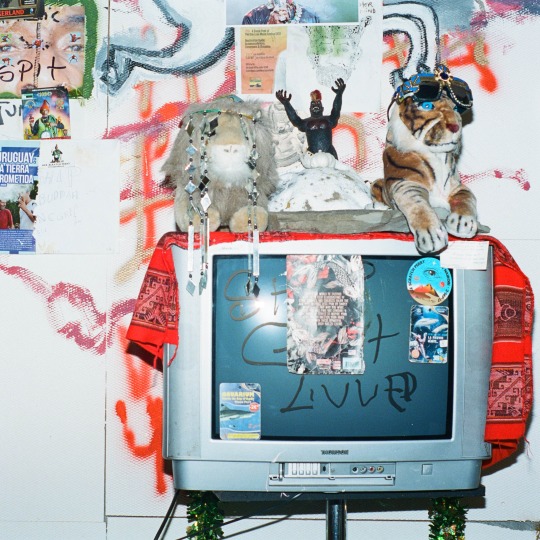
“Blue Ark with TV Sculpture (studio view)” © Lee Scratch Perry, 2016-2021. Photo: Camille Spiller. Courtesy: The Visual Estate of Lee Scratch Perry / suns.works.

“Blue Ark (studio view)” © Lee Scratch Perry, 2016-2021. Photo: Claude Barrault. Courtesy: The Visual Estate of Lee Scratch Perry / suns.works.
Last but not least, the resale of some of his artworks at auctions needs to be mentioned too, let alone the fact that Jean-Michel Basquiat himself called him a significant source of inspiration for his paintings, according to multi-disciplinary artist Lee Jaffe as well as the Gagosian Quarterly (Winter 2021 Issue).
A whole set of signals which suggests a more than bright future for Lee “Scratch” Perry in the modern and contemporary art world.

“Vanity Struck Me in My Tooth”, © Lee Jaffe in collaboration with Jean-Michel Basquiat, acrylic on Cibachrome print, 203 x 122 cm, 1983.

“Avenge” © Peter Harris and Lee “Scratch” Perry, marker pen, oil, acrylic paint on canvas, 124 x 95 cm, 2009. This work of art has been bought by Adrian Sherwood; it can be seen in the video below shot in 2022 in the deck-out living room of the producer.
youtube
Horace Andy : Tiny Desk (Home) Concert.
Books :
People Funny Boy: The Genius of Lee “Scratch” Perry, David Katz, 2000, Canongate Books, 538 pages.
Lee “Scratch” Perry: People Funny Boy, David Katz, 2012, Camion Blanc, 990 pages (French edition).
People Funny Boy: The Genius of Lee “Scratch” Perry, David Katz, 2021, Orion Publishing Group Limited, 688 pages (revised and expanded English edition).
Lee Scratch Perry: Black Ark, Andreas Koller & Lorenzo Bernet (Ed.), publication expected in July 2024, Edition Patrick Fey, 600 pages (500 illustrations).
Films :
Lee Scratch Perry’s Vision of Paradise, Volker Schaner, 2015, 100 min.
This article is the English, revised and expanded version of my paper published on Reggae.fr on 30 November 2023. © Jérémie Kroubo Dagnini (JKD).
#lee scratch perry#contemporary art#adrian sherwood#par reggae.fr#reggae#art#Youtube#art museum#collage art#installation art#jamaica#ray davies#the kinks#gagosian#basquiat#afrofuturism#afrofuturistic#artwork#drawings#installation#outside art#smithsonian#salvador dali#sun ra arkestra#george clinton
7 notes
·
View notes
Text
Indian 🇮🇳Japanese🇯🇵 Korean 🇰🇷American🇺🇸 griffin 

Vivian
Age:21
Gender:nonbinary
Gender bc: 50%female tiger and 50% male peafowl
Hobbies:eating Japanese food Indian food Korean food American food being enimies with a purple laotian Turkish American cat listening to rap K-pop jpop indian music reggae and being friends with Indians Koreans Japanese and Americans
2 notes
·
View notes
Text
18/01/23 ~ NTS Radio ~ Ryuichi Sakamoto Special
For the past 2 months I've listened to every album, soundtrack, composition, live recording that Ryuichi Sakamoto has made. There have been a lot of tears. A lot of reflection on life, on mortality, on social harmony and the environment. A loooot of emotions have been felt.
All of this research has solidified my respect for Sakamoto as an artist. A true pioneer. A maestro. Condensing his career into 2 hours has been difficult, but I hope you enjoy the show and my notes.
~~~~~~~~~~~~~~~~~~~~~~~~~~~~~~~~
Ryuichi Sakamoto has released over 20 solo studio albums, 10+ live albums, several compilation albums, over 40 EPs and singles, and about 48 soundtracks.
1978 - Thousand Knives - Plastic Bamboo
Sakamoto’s first solo album, created with the help of Hideki Matsutake who was known as the 4th member of YMO. The album fused electronic music with traditional Japanese sounds whilst incorporating elements of modern classical and reggae.
On the album cover, from Taeko Onuki “I was told that the jacket he’s wearing was an Armani and chosen by Yukihiro. I had only known Sakamoto in jeans and rubber sandals and he said to me, “What do you think?!
2. 1980 - B-2 Unit - Riot in Lagos
Sakamoto’s “edgiest” album. B-2 Unit birthed Riot In Lagos which is said to be an early example of electro. Several electro and hip hop artists were influenced by the album, especially Riot In Lagos.
“Differencia" has, according to Fact, "relentless tumbling beats and a stabbing bass synth that foreshadows jungle by nearly a decade". Some tracks on the album also foreshadow genres such as IDM, broken beat, and industrial techno. For several tracks on the album, Sakamoto worked with Dennis Bovell, incorporating elements of afrobeat and dub.
Another recommended track: E-3A
3. 1981 - Left-Handed Dream / Hidari Ude No Yume - Kacha Kucha Nee
Sakamoto wanted to record an album rooted in pop and created Left-Handed Dream (or Hidari Ude No Yume), which displays a variety of global influences through the instruments used - marimba, didgeridu, traditional Japanese instruments such as the sho and hichiriki flutes. The album showcased Sakamoto’s ability to seamlessly combine Eastern and Western sounds, strengthened through collaborating with Talking Heads guitarist Adrian Belew & co-producing with Robin Scott.
Venezia would then become the Left Bank!
4. 1982 - Bamboo Houses
Sakamoto continues his long-standing collaboration with David Sylvian of Japan, Sylvian’s first solo project outside of the band. Featuring Steve Jansen on drums.
5. 1983 - Merry Christmas Mr Lawrence Soundtrack - Forbidden Colours
Sakamoto’s first film score, for Merry Christmas Mr Lawrence which he also starred in alongside David Bowie. David Sylvian contributed lyrics and vocals on Forbidden Colours, which became a hit and a vocal version of the main theme, Merry Christmas Mr. Lawrence. The soundtrack won a BAFTA Award for Best Film Music in 1984.
Another recommended track: Germination
6. 1984 - Ongaku Zukan - Etude
Ongaku Zukan was an experimental album with no deadline - created around Sakamoto’s incredibly busy schedule in 1983, which saw Yellow Magic Orchestra pause their group activities after an intense 8 years of recording and touring. Features from Hosono, Takahashi, Minako Yoshida and Tatsuro Yamashita.
Sakamoto recalls he got started on the album without having a clear direction for its content: "Making an album without a blueprint...... it's an adventure to see what happens like when you embark on a sea voyage without a compass or chart. If you follow a blueprint, you will be able to record efficiently and in a short period, but I removed all of that and made it that way."
Sakamoto likens this production method to "automatic writing", which is known as one of the methods of surrealism:
"I went into the studio and recorded what came out without any prejudice...... I made it as if in a kind of trance. It could be something classical, it could be pop. Regardless of style and unity, the major premise was to accept everything that was made, so we created a lot of songs."
7. 1985 - Esperanto - A Rain Song
Sakamoto’s 6th solo album, orginally composed for a performance by New York choreographer Molissa Fenley. An experiment with new sampler technology - apparently Sakamoto needed a huge computer to make this score.
Another recommended track: A Wongga Dance Song
8. 1986 - Futurista - GT
Futurista (未来派野郎, translates literally as "Futurist Bastard") was created as a response to the Futurist Movement - an artistic and social movement originated in Italy. Mid 80-s avant-garde synthpop perfection!
Sakamoto samples a lot throughout this album - G.T. samples “Legs” by Art of Noise.
9. 1986 - Illustrated Musical Encyclopedia - Field Work (ft. Thomas Dolby)
The reissued English titled version of Ongaku Zukan, intended for the international market. It combines about half of the tracks from the 1984 album with newer singles "Steppin' Into Asia" and "Field Work” ft. Thomas Dolby.
10. 1987 - Neo Geo - Risky ft. Iggy Pop
The term "neo geo", or "new world", is derived from Sakamoto himself as a way to describe worldwide musical diversity in regard to genre (similar to world music and world beat). Again, showcasing Sakamoto’s ability to combine Eastern and Western musical styles.
Bootsy Collins on bass!
11. 1987 - The Last Emperor Soundtrack - First Coronation
The soundtrack features 9 pieces composed by Sakamoto, 5 by David Byrne & 1 from Cong Su. The album won Best Original Score at the 1988 Academy Awards.
12. 1989 - Beauty - You Do Me
8th solo studio album, which sees his solo career begin to extend outside of Japan. Beauty is notable for its "collage of styles" that range from rock, techno, and classical to flamenco, African, and Japanese traditional, featuring a long list of collaborators.
In discussing whether music is narrative and illustrative or an abstract medium, Sakamoto said, "I have visions sometimes when I'm writing contemporary music, even when it's very logical. For example, for one of my songs on the album Beauty, I was always having visions of Amazonian rainforests, a little plane flying very low over the trees. Trees, trees, trees, and some birds. But the title of the song is 'Calling from Tokyo'".
13. 1991 - Heartbeat - Rap to the World
Sequel from Beauty, still collaging sounds from all over the world, this time in an eclectic upbeat fashion. You can hear the dance music influences throughout this album, which is enforced through the credits - notably Towa Tei and Satoshi Tomiie.
14. 1994 - Sweet Revenge - Same Dream, Same Destination
One of my least favourite Sakamoto albums - the strings are beautiful but a lot of the vocals miss for me. But this song + the cover is iconic! Maybe he was just gearing up for his next album, Smoochy.
The album title refers to Sakamoto’s wish to bring a sense of melody back to the “rhythm-obsessed pop-world”.
15. 1995 - Smoochy - A Day In The Park
An exploration of the old world meeting the future - Sakamoto combines Latin tinged sounds, jazz and the possibilities of the internet through electronic experimentation with an “listening” approach running throughout Smoochy.
16. 1996 - 1996 - Bibo no Aozora (Trio World Tour Live recording)
1996 contains a selection of Sakamoto's most popular compositions plus two new compositions, all arranged for a standard piano trio. The arrangement of "Bibo no Aozora" that appears on this album has appeared in several film and television projects.
A concert, called Ryuichi Sakamoto Trio World Tour, was organised in 1996. This concert was played at 6 venues in Japan, and the Bunkamura Orchard Hall concert was live streamed on August 28, 1996 on the Internet, and was one of the first concerts to be streamed.
17. 1997 - Discord - Salvation
Sakamoto’s first full length orchestral work, which sees him contrasting modern musical tools with traditional instruments. Amongst procrastination and self-imposed deadlines, Sakamoto wrote the four movements in Discord ("Grief," "Anger," "Prayer," "Salvation") in a month. He finished writing the last notes on the morning of the first rehearsal with the orchestra.
Salvation features spoken word contributions from Laurie Anderson, DAvid Byrne, Patti Smith and Banana Yoshimoto.
18. 1998 - BTTB (Back To the Basics) - Energy Flow
Sakamoto was stuck in a traffic jam and melody popped into his head. That melody would then become Opus - the opening track of his solo piano album, BTTB - Back To The Basics. BTTB & Discord see Sakamoto’s departure from his pop-tinged outputs as he returns to the piano.
19. 2002 - Elephantism - Great Africa
Elephantism stands out from the rest of Sakamoto’s discography as it’s his first venture into new-age, ambient sounds with elements of African musical styles, featuring field recordings.
Elephantism is a reflection of Sakamoto’s life ethos, where he strives for world peace. In his search for harmony, he turns to nature - specifically the elephant. “Elephantism is the state of being compassionate, loyal and loving towards family and friends, and being understanding and generous in attitude toward other clans; it means being big and expansive in your outlook on life, not small and mean; it means showing thoughtful consideration, wisdom and dignity when necessary, but in equal measure showing powerful expression and emotion, and being, yes, a little wild and passionate now and then!”
20. 2002 - Works I - CM - Old I (Suntory 1983)
Compilation of music written for various commercials (called CM in Japan), all works are from 1983 to 1984. Monopoly is a favourite (didn’t have enough time to include it in the show!)
21. 2004 - Chasm - Ngo/Bitmix
Sakamoto’s 15th solo studio album. Chasm is experimental, combining the paion with ambient and glitch programming. Features contributions from Hosno and Takahasi, under their Sketch Show alias.
22. 2005 - Insen - Avaol
Sakamoto and Alva Noto’s second studio album - their collaboration began in 2002. “Both explore the potential for interaction and tension between electronic and acoustic instrumentation”.
23. 2009 - Out of Noise - composition 0919
Sakamoto was one of a handful of concerned artists who took part in The Cape Farewell Project, where scientists joined with the creative community for a conference in Greenland to address and investigate global warming. During his stay in Greenland, Sakamoto made a number of field recordings that he incorporated into his album Out of Noise; the album is dominated by graceful, minimalist keyboard pieces punctuated by electronic noise, ambient sounds and bits of found voices.
24. 2017 - async - Zure
Sakamoto’s 19th studio album - his first one in 8 years since Out of Noise. It’s also his first full length solo record since recovering from throat cancer in 2015. During this 8 year “break” he felt uninspired with the composition process and focused on scoring films. Despite his recovery, Sakamoto thought that async would be his last album. "That’s why I tried to forget all the rules and forms, anything. I just wanted to put down just what I wanted to hear, just a sound or music, it doesn’t matter. This could be the last time."
He began making async in 2016 and completed it in 8 months.
Async is unusually textural, featuring both acoustic and electronic elements plus samples recordings readings and field recordings of city streets. Sakamoto’s worries of death seep into the album, which were influenced by his experience with cancer and the many earthquakes and tsunamis in Japan in 2011. “We were warned about how our civilisation is fragile and how the force of nature is great."
25. 2023 - 12 - 20220123
Maybe one of Sakamoto’s most moving albums.
His breath can heard throughout 12 like a metronome - keeping time, evoking the feeling of a warm embrace and making us are of how fleeting life is. It has a palpable level of intimacy to it, as if you’re in the room with him as he plays the piano.
~~~~~~~~~~~~~~~~~~~~~~~~~~~~~~~~
Ending on a few of my favourite Sakamoto quotes:
"I hate to divide the world -- East and West. Where is the edge? My music is much more melting."
"I want to be a citizen of the world. It sounds very hippie, but I like that."
20 notes
·
View notes
Text
Omega WUSB Summer 2022 Broadcasting Season.
In Summer 2021, Omega WUSB had a feeling that it'd be extremely busy. On top of our alternating 10PM-midnight Saturday slot, our then-program director Luke allowed us to temporarily take over the alternating midnight-3AM Wednesday slot. We’ve played an almost equal amount of deluxe and bonus sets along with two label tributes for a total of seventeen shows, including a double-deluxe street / backpacker set and our first-ever African sounds showcase. With three other fill-ins in the mix for absent dee-jays, Omega WUSB's Summer 2021 broadcasting season became our busiest broadcasting season we’ve ever had.
Or so we thought.
In Summer 2022, our then-program director DJ Joi offered us a weekly Monday 11AM-noon slot and we immediately took it. With six deluxe slots, fourteen bonus shows, and two label tributes, Omega’s Summer 2022 broadcasting season was our biggest ever. For our deluxe shows (new, current, and relevant sounds), we featured top-shelf indie, post-punk / d.i.y, hardcore, metalcore, sludge, doom, stoner, backpacker, street, electronic, ultrapop, shoegaze, and marquee artists. For our bonus shows, we showcased classic punk, d-beat, thrash, noise, African sounds, crate-digging, and golden-era hip-hop. For the first time ever, we had our very first Japanese sounds and all riot-grrrl shows, plus a 4th of July New York hardcore set was all to its own. We featured two record label showcases in Captured Tracks and La Vida Es Un Mus. We also had an unprecedented three double deluxe (four-hour) sets thanks to our preceding show Everything Must Go. Finally, in a first for our show, we did two broadcasts in one day, and that was on the 4th of July. We done everything we did last year and more. The only ones out? Our jungle / drum-and-bass and breakbeat sets. Not since Year Four had we visited them.
Of course, there were some hitches. We had a bye-week to make way for WUSB’s Summer 2022 Reggae Marathon, leaving us with six bi-weekly deluxe broadcasts instead of seven. Our show before us, Everything Must Go, was more than generous to donate his time to us which became our three double-deluxe shows. And with three weeks to go before the end of our Summer broadcast season, our program director made scheduling changes which took effect before August’s end and replaced our final two weekly Monday bonus broadcasts with another show. Thanks to one of our station’s at-home programming engineers, those final two shows were played ahead of time as fill-ins for an absent dee-jay. Everything worked out in the end as we hope to be.
Now, our Summer 2022 broadcasting season is on record the busiest one we’ve ever done. We never backed down from a challenge and our mission of presenting innovative, non-commercial programming for our local and worldwide listeners kept us going. We exemplified independent radio in delivering on being diverse and stretched the limits of what we can do, as we always have.
We hoped all of our followers and listeners of all things Omega enjoyed hearing us through our most ambitious run ever.
June 4, 2022; #308 (double-deluxe shoegaze, indie)
June 6, 2022; #309 (vinyl, crate-digging, sampling)
June 13, 2022; #310 (marquee)
June 18, 2022; #311 (metalcore, sludge, stoner, doom)
June 20, 2022; #312 (old-school, boombox hip-hop / rap)
June 27, 2022; #313 (classic punk, proto-punk, punk legends)
July 4, 2022 A; #314 (Captured Tracks tribute)
July 4, 2022 B; #315 (New York City hardcore legends)
July 11, 2022; #316 (daylight noise)
July 16, 2022; #317 (double-deluxe electronics and super-pop)
July 18, 2022; #318 (African sounds expo-)
July 25, 2022; #319 (ultra)
July 30, 2022; #320 (double deluxe noise rock, hardcore)
August 1, 2022; #321 (industrial winners)
August 8, 2022; #322 (punk, thrash, d-beat)
August 13, 2022; #323 (post-punk, d.i.y., city sounds)
August 15, 2022; #324 (all-Japan showcase)
August 22, 2022; #325 (street)
August 27, 2022; #326 (hip-hop, rap, golden-era veterans)
August 29, 2022 A; #327 (La Vida Es Un Mus tribute)
August 29, 2022 B; #328 (all riot-grrrl showcase)
And in case anyone of our followers were wondering, here’s what we did the previous summer:
June 2, 2021; #266 (vinyl, crate-digging, sampling)
June 5, 2021; #267 (electronics)
June 16, 2021; #268 (golden-era hip-hop, rap)
June 19, 2021; #269 (indie)
June 30, 2021; #270 (thrash, speed, crust punk)
July 3, 2021; #271 (double deluxe hip-hop)
July 10, 2021; #272 (shoegaze, alternative, dreampop)
July 14, 2021; #273 (classic punk)
July 17, 2021; #274 (metalcore, sludge, stoner, doom)
July 28, 2021; #275 (noise, obscura)
July 31, 2021; #276 (hardcore)
August 2, 2021; #277 (Mexican Summer tribute)
August 11, 2021; #278 (hip-hop / rap anniversary)
August 14, 2021; #279 (noise rock, garage)
August 25, 2021; #280 (African cassette expo-)
August 28, 2021; #281 (post-punk, d.i.y., city)
August 30, 2021; #282 (Awesome Tapes From Africa tribute)
1 note
·
View note
Text
starter for @fmdxsuji / gsm building
tackling on too many things — that’s never been of issue. but as of late, he feels nothing short than being spread out so thinly that his knees start buckling with each step that drags him through gold star’s hallways. call it a physical reaction, or maybe, it’s just the effect of his fifth americano of the day and a cesspool of work left to be unfinished.
luckily, he’s packed his smoke break to the brim. the stench probably lingers, but then again, he’s never given two shits as to how he presents, nonetheless to a label mate he barely knows.
they’re better off being called strangers with the abysmal interactions. yet, his resume consists of nothing more than what feels like: gold star in-house producer number one. (he makes himself at home when he opens the door, tosses a nod in lieu of a formal greeting, finding some sort of fixture in the empty seat by the production table).
“so, i’m gonna be upfront now. i’ve created so much shit in the past weeks from reggae to classical mixtures to edm — the only idea i have left is city pop. inspired by japanese pop from the ‘80s.” he tilts his view to meet hers, a beat of silence for the response before he cuts that short too. “a stretch from your ballading career, but take it or leave it as you will.”
13 notes
·
View notes
Text
I asked Emilia about Italy Math Rock, sadly he said there was a few Math Rock band in Italy, i dunno what Italy ppl music?
Japanese has a lot of Math Rock band, i mention österreich or Cö Shu Nie or i listen Japanese song alot. Like, i won't judge their music knowledge esp " OMG, Lionfield has shallow music references "
He said there were top 40, reggae, pop, rock, but i rarely see Math Rock / Alternatives ;-;
I listen a lot of alternative genres in my life, as i said like no wonder i can't fit ppl here. Sometimes, i feel like my playlists are too weird
4 notes
·
View notes
Text
How do different cultures interpret respect in their music?
Music serves as a reflection of cultural values, beliefs, and social norms. Across the globe, the concept of respect is interpreted and expressed in unique ways, and this diversity is often showcased in the music of different cultures. Respect Songs convey messages about dignity, self-worth, social harmony, and community values in ways that resonate deeply with their respective audiences. In this blog post, we will explore how different cultures interpret respect in their music, examining the themes and messages that shape Respect Songs around the world.

1. African American Culture: Respect as a Demand for Equality and Dignity
In African American culture, respect is closely tied to the historical struggle for civil rights and social justice. Many Respect Songs in African American music are calls for recognition, equality, and the acknowledgement of inherent human dignity. This interpretation of respect is rooted in the long history of discrimination and the fight for civil rights.
One of the most iconic Respect Songs is Aretha Franklin’s “Respect.” Originally written and recorded by Otis Redding, Franklin transformed the song into a powerful anthem for both the civil rights and feminist movements. Her version of the song became a declaration of self-worth and a demand for respect from a society that often marginalized African Americans and women. The song’s refrain, “R-E-S-P-E-C-T,” became a rallying cry for those fighting for equality.
In African American culture, respect is not just a personal expectation—it is a societal demand. This is reflected in the soul, R&B, and hip-hop genres, where artists like Marvin Gaye, Nina Simone, and Kendrick Lamar have used their music to address issues of racial inequality and demand respect for their communities.
2. Jamaican Culture: Respect as Unity and Justice in Reggae Music
In Jamaican culture, reggae music has been a central medium for expressing themes of respect, unity, and social justice. Rooted in Rastafarian beliefs, reggae often emphasizes the importance of respect for all people, regardless of their background, and promotes messages of love, peace, and equality.
Bob Marley, one of the most influential reggae artists, frequently addressed respect in his music. Songs like “One Love” and “Get Up, Stand Up” promote messages of unity, equality, and mutual respect. In “One Love,” Marley sings, “One love, one heart, let’s get together and feel all right,” calling for unity and emphasizing the importance of respecting one another regardless of differences.
In reggae music, respect is closely linked to social harmony and justice. It reflects a cultural emphasis on community, compassion, and the rejection of oppression. This interpretation of respect encourages listeners to recognize the inherent dignity of others and work towards a more equitable society.
3. Japanese Culture: Respect as Honor and Social Harmony
In Japanese culture, respect is deeply ingrained in social interactions and traditions. The concept of “wa” (harmony) and the importance of maintaining social balance are central to how respect is interpreted. In Japanese music, themes of respect often emphasize honor, humility, and maintaining harmonious relationships within society.
Enka, a traditional Japanese music genre, frequently explores themes of respect, duty, and social harmony. Songs in the enka genre often reflect a deep respect for family, community, and cultural traditions. For example, the enka song “Kawa no Nagare no Yō ni” (Like the Flow of the River) by Misora Hibari speaks to the resilience and grace required to navigate life’s challenges while maintaining respect for oneself and others.
In Japanese pop and contemporary music, themes of respect continue to emphasize social harmony and mutual consideration. Lyrics often focus on expressing gratitude, showing humility, and upholding social values. Respect in Japanese music is about honoring one’s relationships, fulfilling social roles, and preserving communal harmony.
4. Latin American Culture: Respect as Love, Resilience, and Community
In Latin American cultures, respect is often intertwined with themes of love, resilience, and community. Music in these cultures frequently reflects the importance of familial bonds, social solidarity, and the resilience needed to overcome adversity. Respect is interpreted not only as personal dignity but also as a recognition of one’s responsibility to family and community.
In traditional Latin American genres like bolero, mariachi, and salsa, songs often emphasize respect within the context of romantic relationships and family dynamics. For example, in many bolero songs, respect is portrayed as a key element of love and devotion. Artists like Luis Miguel have sung about the importance of honoring and respecting romantic partners in songs like “La Gloria Eres Tú” (You Are the Glory).
In genres like reggaeton and Latin pop, respect is also linked to self-empowerment and resilience. For example, in her hit song “La Bicicleta,” Shakira sings about cultural pride and self-respect, celebrating her roots and her identity.
Across Latin American music, respect is portrayed as a multifaceted value, encompassing love, community, and personal strength. It emphasizes the importance of acknowledging and valuing others while also embracing one’s own identity and cultural heritage.
5. Indian Culture: Respect as Reverence and Devotion in Music
In Indian culture, respect is often interpreted as reverence and devotion, particularly in the context of spiritual and familial relationships. Music in India frequently explores themes of respect through expressions of devotion to deities, elders, and the family unit. This cultural emphasis on respect is evident in traditional Indian music, including bhajans (devotional songs) and classical genres like Hindustani and Carnatic music.
In bhajans, respect is often portrayed as a form of spiritual devotion. Songs like “Raghupati Raghav Raja Ram” express reverence for deities and emphasize humility and devotion as core aspects of respect. In classical Indian music, the theme of respect extends to the teacher-student relationship, reflecting the cultural importance of respecting one’s guru (teacher).
In Bollywood music, themes of respect often center around family values, romantic relationships, and social responsibilities. For example, the song “Tujh Mein Rab Dikhta Hai” from the film Rab Ne Bana Di Jodi expresses respect and devotion in a romantic context, reflecting the cultural importance of honoring one’s partner.
In Indian music, respect is closely linked to reverence, humility, and fulfilling one’s duties within spiritual, familial, and social contexts.
6. Middle Eastern Culture: Respect as Honor and Tradition in Music
In Middle Eastern cultures, respect is often interpreted in terms of honor, tradition, and social responsibility. Music in this region frequently emphasizes respect within the context of family, community, and cultural heritage. Traditional Arabic music, such as tarab and maqam, often explores themes of respect, love, and honor in poetic and emotional ways.
For example, in Arabic music, artists like Fairouz and Umm Kulthum have sung about themes of love, resilience, and social values. Umm Kulthum’s songs often reflect respect for cultural traditions and express emotions tied to social and familial responsibilities. Songs like “Alf Leila wa Leila” (One Thousand and One Nights) emphasize the importance of honoring relationships and fulfilling social roles.
In Middle Eastern cultures, respect is portrayed as a balance between honoring one’s heritage, fulfilling one’s duties, and showing dignity to others. Music in this region often reflects the cultural significance of upholding social values and traditions.
Conclusion
Different cultures interpret respect in their music in unique ways, reflecting the values, beliefs, and social norms that shape each society. In African American culture, respect is often linked to the demand for equality and recognition. In Jamaican culture, reggae emphasizes unity and social justice. In Japanese culture, respect is tied to honor and social harmony, while in Latin American cultures, it is associated with love, resilience, and community. Indian culture emphasizes reverence and devotion, and Middle Eastern cultures highlight honor and tradition.
By exploring these diverse interpretations of respect in music, we gain a deeper understanding of how this universal value is expressed and celebrated around the world. If you’re interested in discovering more about the powerful messages conveyed in Respect Songs, explore the music of different cultures and let their interpretations inspire you to embrace respect in all its forms.
0 notes
Text
Miki Hirayama
The smooth and funky sound of prime-time Japanese reggae pop in the 1970s and ’80s fired up an obsession with Jamaican music that persists to the present day. If there is a year zero for the introduction of reggae music to Japan, you’d be forgiven for thinking it was 1979 when Bob Marley and the Wailers toured the country, trailed by an entourage of journalists, photographers and fans ready to…

View On WordPress
0 notes
Text
Take a listen to my music album HIDEMI. https://t.co/VSNRZF3UTc #music #song #artist #stream #download #Japan #Japanese #pop #rock #reggae #sunrise #neighbor #lousy #album https://t.co/sWD59fdsBZ
Take a listen to my music album HIDEMI. https://t.co/VSNRZF3UTc #music #song #artist #stream #download #Japan #Japanese #pop #rock #reggae #sunrise #neighbor #lousy #album https://t.co/sWD59fdsBZ
— Hidemi Woods (@88thplanet) May 14, 2023
from Twitter https://twitter.com/88thplanet
1 note
·
View note
Note
what kind of music do you listen to
Honestly a whole bunch. My main playlist is reggae and surf rock. A lot of Hippo Campus, Bob Marley, Slightly Stoopid, Jack Johnson, Sublime. Kinda just a mix of beachy, west coast vibes.
Other playlists I have are a lot of pop punk, outlaw country, some big band (esp Dean Martin), been getting into Japanese Ambient Minimalism like Hiroshi Yoshimura lately. I’m a big jazz guy, love Bill Evans, Vince Guaraldi, Chet Baker, and Miles Davis.
It’s honestly all over the place😂
1 note
·
View note
Text
BRICKSIDE MUSIC FESTIVAL 2023
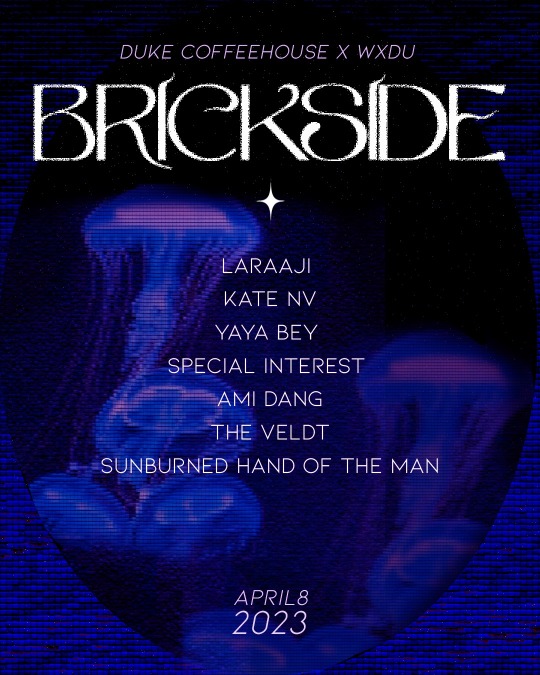
The annual Brickside Music Festival returns Saturday, April 8th at Duke Coffeehouse. Presented by Duke Coffeehouse and WXDU, Brickside will feature performances from local and international artists, including Laraaji, Kate NV, Yaya Bey, Special Interest, Ami Dang, The Veldt, and Sunburned Hand of the Man. Doors open at 2:30 pm and sets will run from mid-afternoon to midnight. There will be food trucks and art-making activities in addition to musical performances ranging from art pop to R&B and from new age to punk rock. Tickets are now for sale at tickets.duke.edu/Online/article/Brickside2023.
SCHEDULE
2:30pm DOORS OPEN 3:00pm Sunburned Hand of the Man 4:00pm The Veldt 5:00pm Special Interest 7:30pm DOORS REOPEN 8:00pm Ami Dang 9:00pm Laraaji 10:00pm Yaya Bey 11:00pm Kate NV
Laraaji https://laraajimusic.bandcamp.com/music Laraaji is a musician, mystic and laughter meditation practitioner based in New York City. He began playing music on the streets in the 1970s, improvising experimental jams on a modified autoharp processed through various electronic effects. He has since released albums for a variety of labels, often recording himself at home and selling the results as cassettes during his street performances.
Kate NV https://katenv.bandcamp.com/ Kate NV is the multifaceted solo persona of Moscow-based artist Kate Shilonosova. On her latest LP from 2020, Room for the Moon, she makes avant-pop that defies the ordinary, combining Russian and Japanese influences with a new-wave sensibility and featherlight vocals.
Yaya Bey https://yaya-bey.com/ Yaya Bey is one of R&B’s most exciting storytellers. Using a combination oancestral forces and her own self-actualization, the singer-songwriter seamlessly navigates life’s hardships and joyful moments through music. Bey’s newest album, Remember Your North Star, captures this emotional rollercoaster with a fusion of soul, jazz, reggae, afrobeat, and hip-hop that feeds the soul.
Special Interest https://specialinterest.band/home Special Interest is a four-piece punk band from New Orleans, Louisiana combining elements of no wave, glam, and industrial. Front and center are Alli Logout’s commanding vocals and razor-sharp lyrics, which range from high camp satire to insightful political imperatives.
Ami Dang https://www.amidang.com/ Amrita “Ami” Kaur Dang is a South Asian-American vocalist, sitarist, composer and producer from Baltimore. Her sound blends elements of North Indian classical, noise/ambient electronics, beat-driven psych, and experimental dance pop.
The Veldt https://theveldtmusic.bandcamp.com/ The Veldt is a soul-powered shoegaze band who arrived as misfits during the early '90s and reappeared as cult heroes in the mid-2010s. In 2022, the band released Entropy Is the Mainline to God, their first full-length in 24 years, and embarked on a five-week national tour.
Sunburned Hand of the Man https://sunburnedhandoftheman.bandcamp.com/album/that-which-is Sunburned Hand of the Man are a loose knit gang of musical artists from the wilds of Eastern Massachusetts. Over the years, their music has incorporated elements of rock, folk, drone, free jazz, and funk.
0 notes